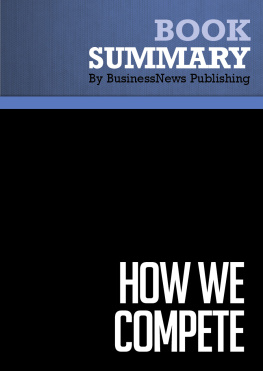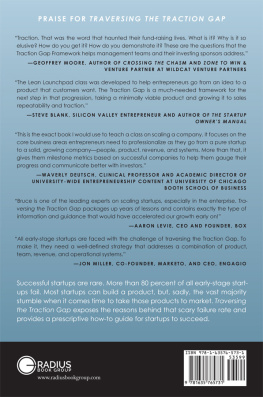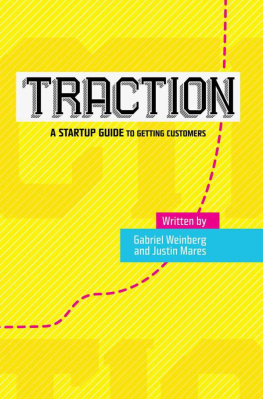Book Presentation: Traction by Gabriel Weinberg and Justin Mares
Book Abstract
All startups have a product. What differentiates the winners from the losers, however, is successful startups generate "traction" real customer growth and momentum. The pursuit of traction in the marketplace should be the central aim of anyone who is trying to get a startup off the ground.

So how do you generate traction? There are at least nineteen channels which have been used successfully by other startups. It's pretty much impossible to tell in advance which of these channels will end up working for you so usually you have to road test a few and then build on what works.
A good framework for identifying which traction channels you should be using is the "Bullseye Framework" which looks like this:
- Brainstorm identify how each traction channel could work for you
- Rank compare the various traction channels using consistent criteria
- Prioritize identify the three traction channels which look most promising
- Test start using those three channels and measure what results
- Focus commit all your resources to the best-performing traction channel
About the Author
GABRIEL WEINBERG is founder and CEO of DuckDuckGo, an online search engine which started in 2008 and delivered more than one billion searches in 2013. He is also an active angel investor. He's been featured on CBS and FOX, and written about in The Guardian and The Washington Post. He previously co-founded and served as CEO of Opobox which was acquired in 2006. Gabriel Weinberg is a graduate of MIT.
JUSTIN MARES is former director of revenue and growth at Exceptional, a software company acquired by Rackspace in 2013. Before that, he founded two other startups, one of which went well and one of which closed down. He runs a growth meetup in San Francisco and writes on marketing in his personal blog at justinmares.com. Justin Mares is a graduate of the University of Pittsburgh.
Important Note About This Ebook
This is a summary and not a critique or a review of the book. It does not offer judgment or opinion on the content of the book. This summary may not be organized chapter-wise but is an overview of the main ideas, viewpoints and arguments from the book as a whole. This means that the organization of this summary is not a representation of the book.
Summary of Traction (Gabriel Weinberg and Justin Mares)
How to think about Traction
Generating traction has to be an obsession for startups. Apply five principles:
- Use Bullseye to start generating traction
- Always spend 50% of your time on traction
- Be prepared to pivot on evidence of more traction
- Watch for channel saturation it's coming
- Always have a traction goal that moves the needle
1. Use Bullseye to start generating traction
Traction is a sign that your company is taking off and will be able to find enough customers to stay in business. The whole point of a startup is you have to grow quickly. Simply put, to keep the doors open as a startup, you need to generate traction ASAP.
There are at least nineteen different channels you can use to generate traction. Companies have excelled using each and every one of them at different times. However, there will usually be just one or two which will work for you. The best way to find your traction channel is to use the Bullseye Framework:
- Brainstorm identify how each traction channel could work for you
- Rank compare the various traction channels using consistent criteria
- Prioritize identify the three traction channels which look most promising
- Test start using those three channels and measure what results
- Focus commit all your resources to the best-performing traction channel
Note you start Bullseye by visualizing how each of those nineteen channels might work out for you in practice. The criteria you then use in step 2 to narrow your choices down to the best three are:
- Which traction channels look most promising?
- How probable is it that this channel might work?
- What would be the cost to acquire a customer?
- How many customers could you reasonably expect?
- How long would it take to see success?
Once you identify your best three traction channels, you then start running some tests for each of those channels. You do this in parallel rather than sequentially so you can get answers quickly. As you run those tests, keep track of:
- How much it costs you to acquire a customer.
- How many customers that channel could generate.
- Whether the customers you get are a good fit.
Most of the time, one of the three channels you test will end up shining for you. When that happens, you then focus all your resources and efforts on optimizing that channel. You keep running experiments in that traction channel to uncover effective tactics and scale them.
It is very likely that one channel is optimal. Most businesses actually get zero distribution channels to work. Poor distributionnot productis the number one cause of failure. If you can get even a single distribution channel to work, you have great business. If you try for several but dont nail one, youre finished. So its worth thinking really hard about finding the single best distribution channel.
- Peter Thiel, founder, PayPal
A startup is a company designed to grow fast. Being newly founded does not in itself make a company a startup. Nor is it necessary for a startup to work on technology, or take venture funding, or have some sort of exit. The only essential thing is growth. Everything else we associate with startups follows from growth.
- Paul Graham, founder, Y Combinator
"Research how past and present companies in your space and adjacent spaces succeeded or failed at getting traction. The easiest way to do this is to go talk to startup founders who previously failed at what youre trying to do."
- Gabriel Weinberg and Justin Mares
2. Always spend 50% of your time on traction
The number one reason that we pass on entrepreneurs wed otherwise like to back is their focusing on product to the exclusion of everything else. Many entrepreneurs who build great products simply dont have a good distribution strategy. Even worse is when they insist that they dont need one, or call [their] no distribution strategy a viral marketing strategy.
- Marc Andreeson, founder of Netscape and venture capital firm Andreeson-Horowitz
"If youre starting a company, chances are you can build a product. Almost every failed startup has a product. What failed startups dont have are enough customers. Many entrepreneurs think that if you build a killer product, your customers will beat a path to your door. We call this line of thinking The Product Trap: the fallacy that the best use of your time is always improving your product. In other words, if you build it, they will come is wrong."
- Gabriel Weinberg and Justin Mares
Traction is so important to the survival of a startup that fully 50% of your time should be allocated to generating traction. You can spend the other half of your time working on your product. This "50% Rule" has several important advantages:










